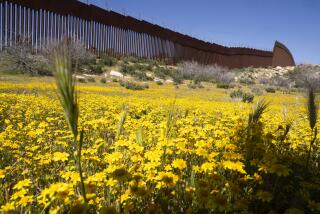Backyard tequila? Planting the blue succulent, Agave tequilana
- Share via
For most garden plants, flowering is a sign of renewed life. That’s not the case with the succulent blue agave (Agave tequilana). Like other agaves, tequilana flowers only at the end of the plant’s life. A 15-foot asparagus-like stalk emerges from the center, sending out puffballs of flowers at the top. The mother plant then dies, but not before producing pups at its perimeter.
Most blue agaves never get to that stage, however. The sugar-rich sap that develops prior to flowering can be fermented into the alcoholic drink called pulque; the heart, or pina, is used in the production of tequila.
Although blue agave does grow well at sea level, it prefers the higher altitudes of its homeland, the 4,500-foot highlands of Jalisco state in western Mexico, where it develops its unique flavor. Like French wine varieties, tequila made from Jalisco blue agave lends qualities that reflect where and how it was produced, and it comes with a registration number that certifies its place of origin.
As a landscape design element, blue agaves can be a dream. The plants are symmetrical, drought tolerant, slow-growing (which translates to less maintenance), able to thrive on hillsides -- and beautiful. The spiny tips, able to pierce the flesh to the bone, are the biggest drawback. Likewise the juice of the flesh can cause skin irritations similar to that of poison ivy. When planting it, gardeners will want to wear leather gloves and wrap the leaves in cardboard.
At the Stanford Avalon community garden in Los Angeles, Norma Garcia picked up a blue agave leaf nearly 3 feet long that she planned to roast on a dry, hot griddle. Once she had burned the outside, she would juice the flesh, getting about 2 cups of liquid from the leaf.
Water and cold are the two primary dangers to blue agave. Protect from frost, and drape a blanket over plants if they have been exposed to frost for more than a few days. Water weekly for the first month after planting, letting the soil dry out. After that once-a-month watering is adequate spring through fall; do not water at all during the winter.
Blue agaves typically live a half-dozen years before flowering, but this final bloom can be postponed for 20 years or more if the plant is kept thirsty.
Other agave species are more readily available, but you can find blue agave online or through Worldwide Exotics, a nursery in Lake View Terrace, and through San Marcos Growers. Some were even spotted over the weekend at a Home Depot.
The Global Garden, our series looking at multicultural L.A. through the lens of its landscapes, appears here on Tuesdays.
JOIN THE CONVERSATION:@latimeshome | pinterest.com/latimeshome | facebook.com/latimeshome | facebook.com/latimesgarden






